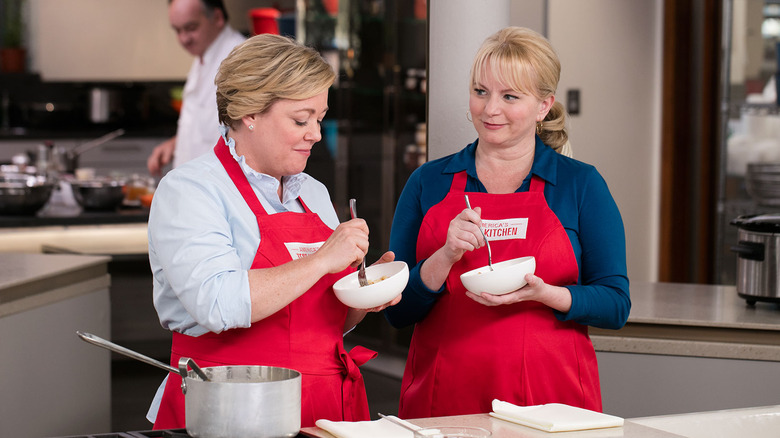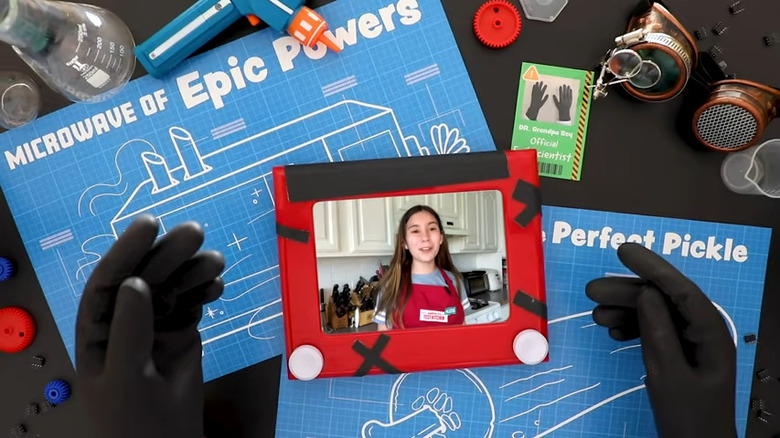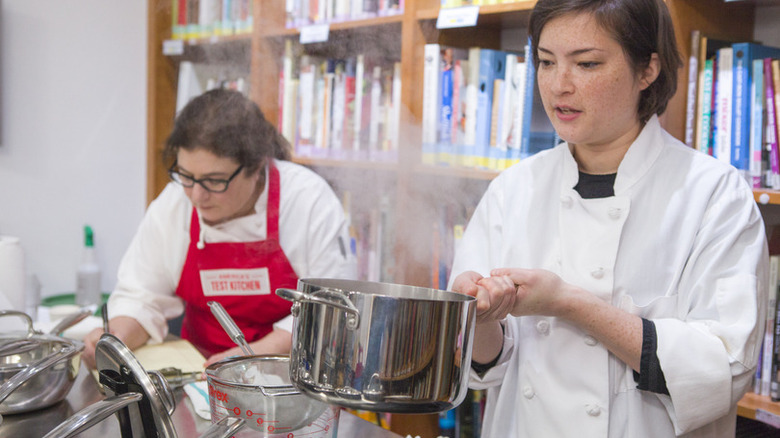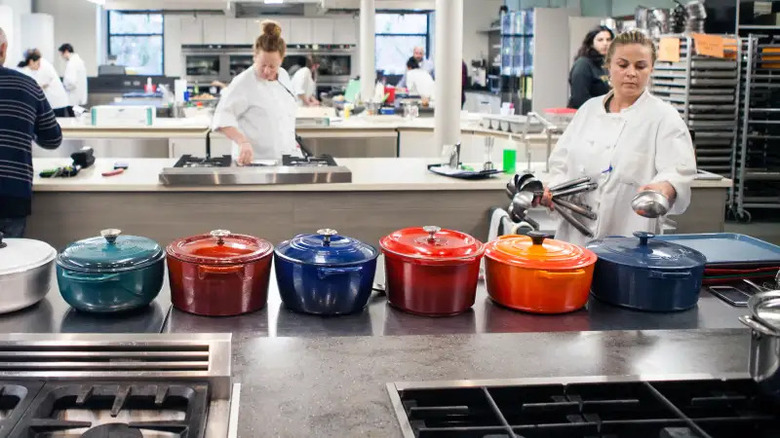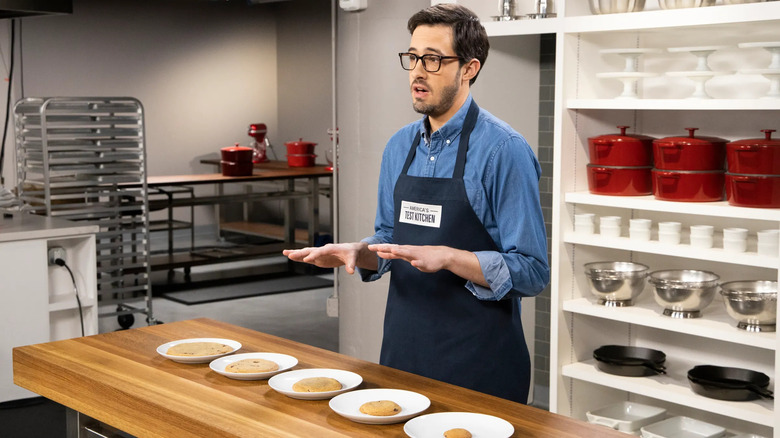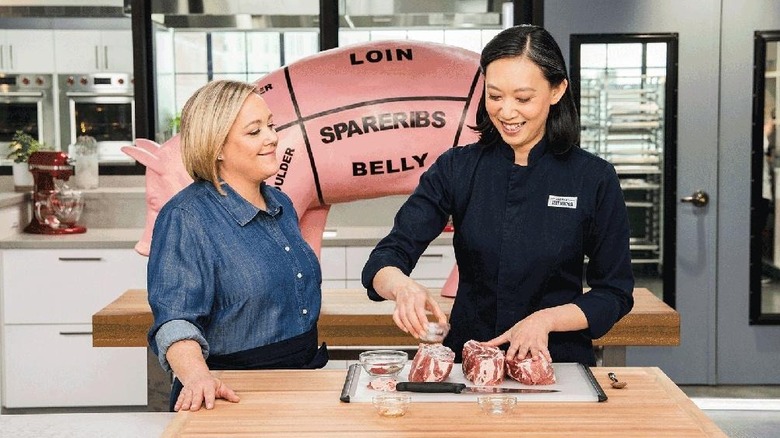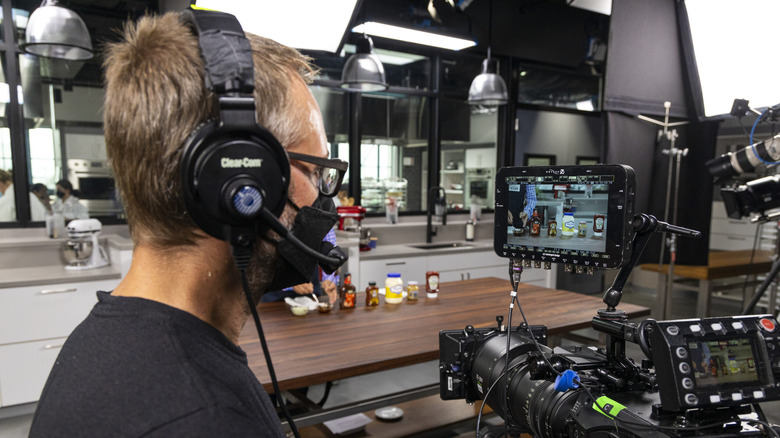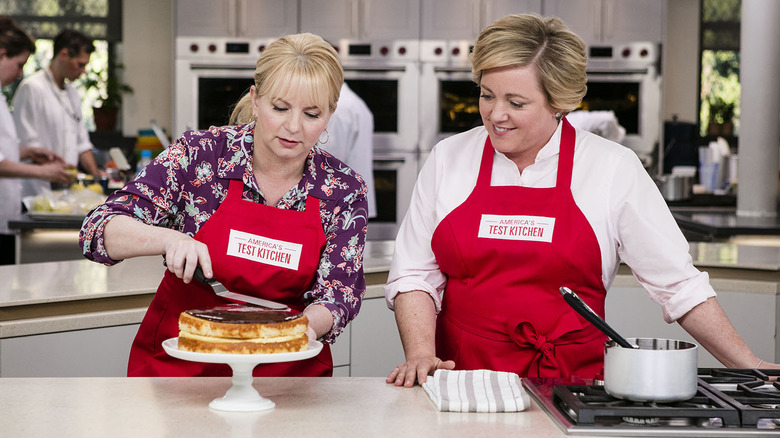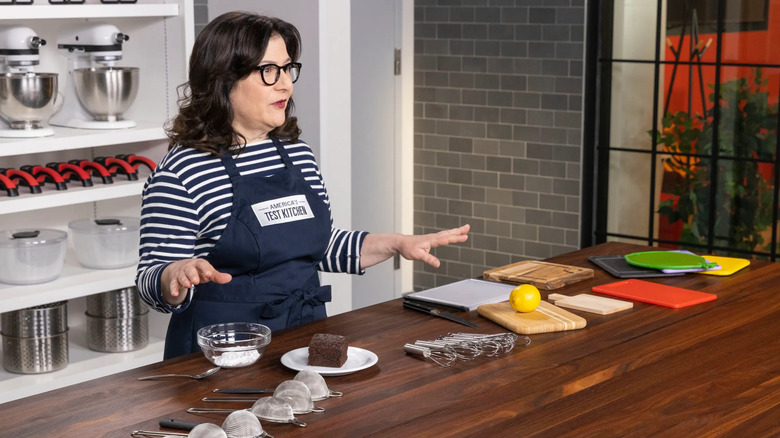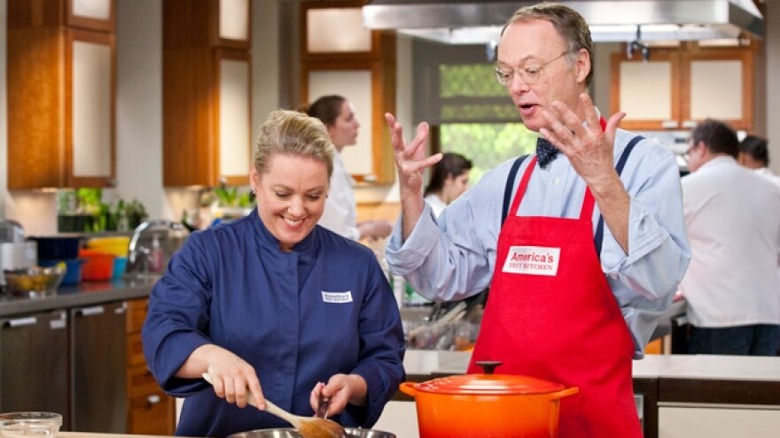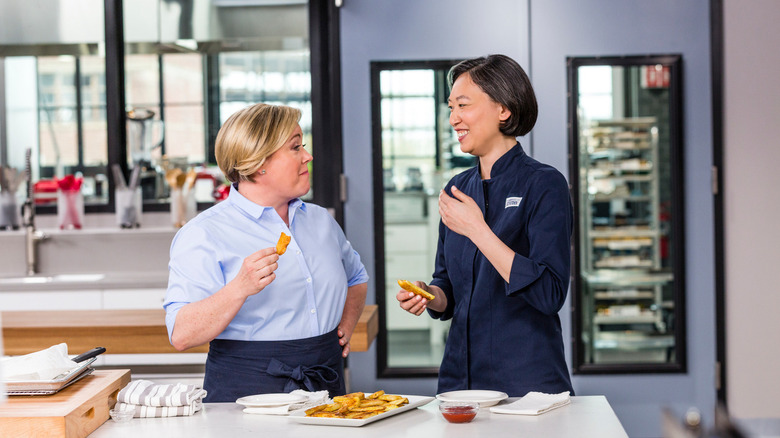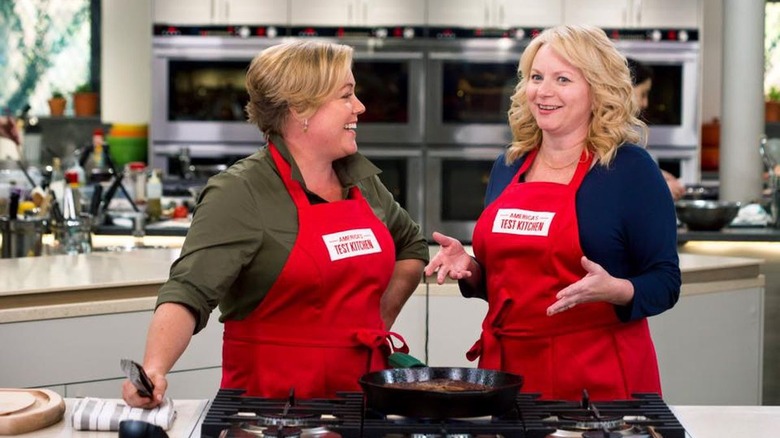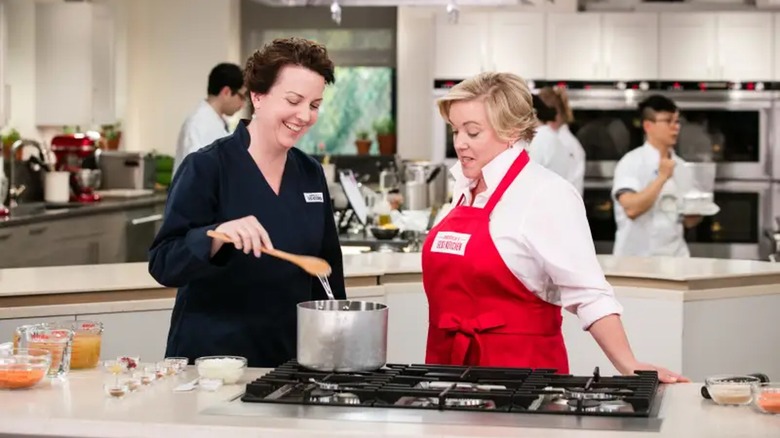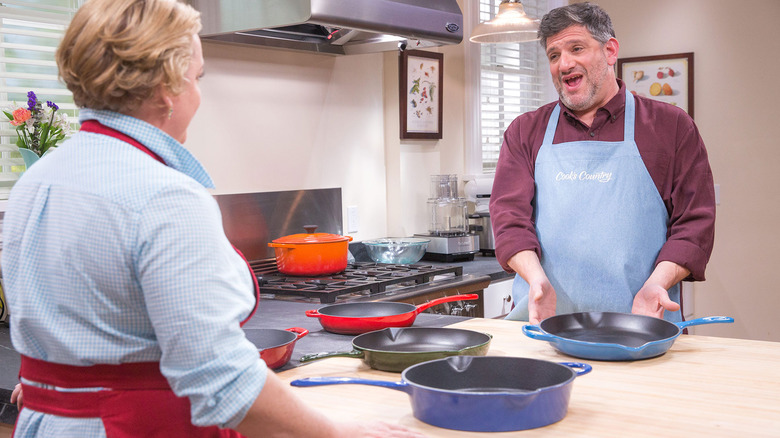What Really Happens Behind The Scenes At America's Test Kitchen?
Airing on PBS for the first time on August 4, 2001, "America's Test Kitchen" was something few viewers had ever seen before. Filmed in a real test kitchen, this almost half-hour-long program shows cooking enthusiasts the best ways to make delicious recipes, which equipment is best suited for their kitchens, and the science behind why different foods pair well with one another. The series, founded by Christopher Kimball, is affiliated with all America's Test Kitchen brands, including "Cook's Country" and "Cook's Illustrated" magazines. The widespread hype behind the series is well deserved, considering the show was still going strong in 2023, with competition series "America's Test Kitchen: The New Generation" building traction of its own.
What seems like a seamless workflow of kitchen experts on television is not what goes on behind the scenes, though. Few viewers know of the extreme preparation that goes into making just one episode, how each piece of equipment is vetted, and how the series producers decide on the recipes they will share with the audience. Oh, and do people know the real reason Christopher Kimball up and left something so special behind? Start reading for the behind-the-scenes scoop on "America's Test Kitchen."
The real reason Christopher Kimball left the show
Christopher Kimball founded the series "America's Test Kitchen," becoming one of the first hosts when it aired back in 2001. While he was not seen in each episode, viewers knew who he was and took his food and recipe expertise to heart. Sadly, Kimball decided to leave "America's Test Kitchen" in 2015. The real reason: he and David Nussbaum, chief executive of Boston Common Press (a parent company of "America's Test Kitchen"), could not come to a contract agreement. Although Kimball had already filmed the 2016 season of the series, he was asked to leave the test kitchen immediately after negotiations did not turn in his favor.
According to Nussbaum, he offered Kimball multiple contracts he deemed reasonable, considering the former host's contributions to "America's Test Kitchen" and its affiliated magazines. Nonetheless, Kimball was not appeased and decided to leave. In an email sent to the employees of "America's Test Kitchen," it was announced that while Kimball would have no on-air time or even operational involvement in the publications or television series, he would still be a minority owner of the company.
America's Test Kitchen laid off 23 employees
When a company is acquired, there are bound to be organizational changes and setbacks. That is exactly what happened to "America's Test Kitchen" in 2023 when Marquee Brands, the owner of various well-known culinary and lifestyle brands, stepped in and decided to take the brand in a different direction. That year, 23 employees were laid off, all of whom worked on "America's Test Kitchen Kids," a program geared towards three to 18-year-olds and which aired on YouTube, a platform kids and teenagers are arguably more likely to utilize than PBS.
"America's Test Kitchen Kids" was comprised of two original shows, "Wicked Good" and "Test Kitchen Kids Takeover," as well as numerous publications and even a podcast. Per Kidscreen, a spokesperson for Marquee Brands said that while laying people off is difficult, they "firmly believe that our decisions will re-position the company for greater success in this ever-changing media environment." Besides the entire "America's Test Kitchen Kids" team, some members of the marketing and books teams were also laid off at the same time.
Each recipe costs around $11,000 to create
If you think your grocery bill is a financial burden you won't come back from, then take a look at "America's Test Kitchen" and the money the show spends on creating just one of its many recipes. On the "America's Test Kitchen" website, it states that one recipe can cost around $11,000, and during an interview with The Kitchn, "America's Test Kitchen" chief creative officer Jack Bishop says that the series spends around $600,000 a year on ingredients alone! According to Bishop, the ingredients are nothing special and are the same supplies people at home buy. The difference is that "America's Test Kitchen" is buying them in bulk to create its many variations of recipes.
Even though the show's grocery bill is very large, it is used to its full extent. Each recipe is tested up to 40 times and tweaked during the various iterations to ensure the best outcome. This process includes at-home tasters, who fill out a survey at the end of each recipe describing their experiences while cooking. "America's Test Kitchen" takes its volunteer at-home testers very seriously, having around 60,000 on standby to hone in-development recipes that have already been meticulously researched and chosen by the staff. From there, a recipe must earn an 80% approval rating from in-home testers before it's moved forward.
Industry equipment is put through a rigorous testing process
Part of the widespread appeal of "America's Test Kitchen" is the equipment portion of the show, where experts chime in on what people should really purchase for their at-home kitchens. To do this, employees at "America's Test Kitchen" put all equipment, from air fryers to cast iron skillets, through a rigorous testing process to ensure they are delivering the best and most informative reviews possible. Plus, they are using the equipment in the test kitchen and wouldn't want to employ subpar products! As of 2023, the "America's Test Kitchen" staff has put over 7,500 products through this intensive testing.
This process takes around six weeks and comprises a whole lot of research, purchasing, analysis, proposal writing, testing, taste-testing food, and more. When it comes to product reviews, "America's Test Kitchen" has shown what it means to set an industry standard. Competitors have even reportedly reached out to learn more about the process and what it takes to make a great review that people will trust.
The test kitchen filming location is for more than TV
Located in Boston's Seaport District, the test kitchen on "America's Test Kitchen" is always busy, even when filming is not in progress. When the show first aired, the test kitchen was pretty small, clocking in at 4,000 square feet of space. Fast-forward to today, and "America's Test Kitchen" now boasts a whopping 15,000 square feet of active kitchen space. While viewers see the kitchen on their television screens, even more goes on behind the scenes while the cameras are not rolling. That's because the test kitchen is where all of the research, analysis, equipment, and ingredient testing comes into play, all of which are aspects that need to happen before recipes are shown on air.
Along with everything the various teams do to prepare for an episode of "America's Test Kitchen," the Boston Seaport location also plays host to tastings. Unfortunately, these are not public tastings and are just for team members who have to get their scripts ready and know what recipes they are going to discuss.
One episode takes months of preparation
Even though an episode of "America's Test Kitchen" typically only clocks in just under a half hour, it takes months of preparation to get the footage needed to make a segment. Before the cameras begin rolling, the ingredient and equipment teams will begin their tests, which will be performed on the respective parts of a segment that only takes a few days to film.
Three months before a segment is filmed, producers and hosts will go over articles and reviews to select a topic they believe viewers will find the most interesting and informative. A selection should be narrowed down when the team is two months out from filming. Then, it's time for everyone to buckle down and get to writing the scripts and thinking up the best way to showcase their segment in front of the camera.
One month before filming, workers must prepare all of the equipment that will be used on camera. This means making sure everything is sparkling clean by the time things are rolling. Three weeks out, the chefs are busy at work, making sure they have all the correct ingredients and going over every aspect of the recipes that will be shown in the episode. When they're good to go, it is finally time to start filming!
A day of filming is meticulously scheduled
Filming an episode of "America's Test Kitchen" does not happen in one day but rather over a few days. Each day begins at 7 a.m. — not including the call time for the talent, who often have to be in hair and makeup even earlier — and ends around 5:30 p.m. And you had better trust that each segment and aspect of the show is scheduled out to the minute. Between each segment, producers and others are busy behind the scenes on walkie-talkies, making sure everyone has what they need in order to succeed during their scheduled filming slot. For example, at 11:35 a.m., Jack Bishop, chief creative officer and one of the regular hosts is likely to be practicing what he will be doing in front of the camera right before it begins rolling. Meanwhile, two other team members coordinate with a taster onset.
For many, the best part of filming days has to be the end. That's not because all of the months of hard work finally paid off but because they can help answer the age-old question of where the food goes after filming comes to an end. At the end of the day, food either gets recirculated to use in other recipes or goes to the "America's Test Kitchen" take-home refrigerator. There, the cast and crew snag some of the delicious meals that were made throughout the day.
The company is all about quality over quantity
Yes, "America's Test Kitchen" has put out many recipes that are showcased on the television show as well as in any numbers of its best-selling cookbooks, such as "The Complete Cook's Country TV Show Cookbook," "Season 16 Edition," "Slow Cooker Revolution," "The How Can It Be Gluten Free Cookbook," not to mention the brand's many magazines. That said, "America's Test Kitchen" is on the lower end of recipe output than other similar companies. "America's Test Kitchen" notes that it has only published a little over 15,000 recipes due to its mission to produce quality food and not merely sprint towards a high quantity. With best-selling cookbooks and a well-received television show, "America's Test Kitchen" is all about churning out the best of the best.
This is perhaps best exemplified through the company's rigorous testing process, which includes both equipment and ingredients put through paces by professionals and at-home testers, the last of whom are pretty much the make or break of a recipe. After all, if a recipe's at-home testing survey does not come back with an 80% approval rating, then it is back to square one — or, in the worst-case scenario, the recipe will get the boot and the research process for a new recipe will begin anew.
There's a recipe process called abuse testing
One of the many tests administered by "America's Test Kitchen" is called abuse testing. It's exactly what it sounds like. Though this process might sound a bit bleak, it helps the chefs know exactly what not to use during a segment. For this test, interns take a recipe and proceed to use bad pots and pans, questionable ingredients, and differing temperatures. By intentionally fumbling a recipe, they hope to find the best way to ensure recipes are perfect when it's time to send them off to the at-home testers and hopefully showcase them in front of the cameras.
As part of the abuse testing process, testers will also switch ingredients in and out, similar to how home cooks might switch out a certain type of milk or cheese, depending on dietary restrictions and taste. Once the abuse testing comes to an end, it is time to send the battle-hardened recipes off to volunteer testers. From there, the recipe either passes or gets sent back for adjustments.
A significant number of recipes are sent back to square one
As it so often goes with other things in life, not every recipe that goes through the testing process and the at-home testers gets approved. In fact, according to Bishop's interview with The Kitchn, at least 20% of recipes get sent back for a revamp. Of course, the reasons recipes return to the drawing board can vary. Sometimes, it might be a confusing phrase in the instructions that needs to be cleared up. Other times, a recipe needs a visual aid to help the chef really understand what they are meant to be doing.
It all comes down to what the at-home volunteers say in their end-of-recipe survey. If the numbers do not come back to "America's Test Kitchen" in the recipe's favor, then it's clear that something went wrong with a majority of the volunteers, and the recipe is not ready for the general public. It is a team effort that gets ready-for-home recipes published. Ultimately, committed as the team is to quality, they agree there is little harm in saying they tried their best, researched all sides, and concluded that it just did not work out as they had hoped.
The landscape of America's Home Kitchen has changed with the times
When "America's Test Kitchen" first aired back in 2001, a lot of thought had to go into what types of recipes they would showcase not only in the television series but also in the brand's publications. The reason was, at least at the time, that some ingredients were not readily accessible in supermarkets. While items such as smoky chipotle peppers and tzatziki are now standard items to find at grocery stores, the employees at "America's Test Kitchen" had to think more practically when the show first got its footing, then switch gears when non-accessible ingredients started to become more of a norm.
During an interview with The Kitchn, Bishop mentioned that, in the early 2000s, people were more often interested in making foods with familiar ingredients. "Twenty-five years ago, everyone wanted to make their grandmother's food," Bishop stated. "Now everyone wants to make the food they had in a restaurant last week." That ability to change with the times can explain how "America's Test Kitchen" has stayed on the air all these years, expanding the brand to "The Next Generation" as well as new cookbooks and other publications.
Sticky dishes are difficult for the test kitchen
When it comes to the dishes made on "America's Test Kitchen," one class is pretty much the bane of the chefs' existence: anything sticky. This includes anything that has caramel, sugar syrups, and fudge. The awful reputation is not because chefs do not care for the dishes but more because they can be a pain to use in recipes. Moreover, at-home cooks do not necessarily follow the precise recipe instructions, may use incorrect pans, and may not have the correct thermometer to gain the readings necessary for making the perfect dish with sticky components.
Bishop told The Kitchn how one of "America's Test Kitchen" recipe developers actually injured themselves via fudge. "One of our recipe developers made 130 batches of fudge, and he literally got a rotator cuff injury," Bishop claimed. Homemade fudge — at least the way "America's Test Kitchen" does it in large quantities and multiple batches — is no joke. A cook working to this level must use a lot of upper body strength to knead the fudge until it is malleable enough to mold, making the rotator cuff injury all too easy to understand.
A lot is built into a half-hour episode
Given that it has a runtime of almost a half hour, it is astounding what "America's Test Kitchen" can achieve in an episode while not seeming rushed. Viewers are shown pretty much every aspect of a recipe as well as equipment testing to show which products are best suited for a given recipe. The same goes for the ingredients, which are discussed in-depth before a host finally tastes a finished dish.
Then comes a science desk segment, which reviews the inner workings of a recipe and how to best achieve a favorable outcome for a dish. The final two segments might be the most practical. First is a tips and tricks segment that goes over kitchen best practices. Then, a gadget expert reviews smaller kitchen appliances people might otherwise overlook. Overall, "America's Test Kitchen" is a well-oiled machine (or kitchen appliance?) that knows what its viewers want and how to achieve it quickly.
Bashing skillets on the ground is part of the job
There is nothing like having a job description that allows you to bash skillets on the ground to see if they are good enough to be on an episode of "America's Test Kitchen." Luckily for Lisa McManus, it is all in a day's work. McManus is paid to abuse products to ensure that "America's Test Kitchen" showcases top-of-the-line equipment while explaining why they should not buy certain brands.
According to McManus, who spoke with CBS in 2019, the abuse test is pretty straightforward. For a stainless steel skillet, the review team will heat it to 500 degrees Fahrenheit before dunking it into a bucket of water that's about 32 degrees. Bringing the pan from one extreme temperature to another is a thermal shock. After the skillet is shocked, it is brought outside and bashed on concrete. If it survives, albeit with dents, breaks, warps, and other testing-induced flaws, it can show viewers what sort of kitchenware is really worth their money.
